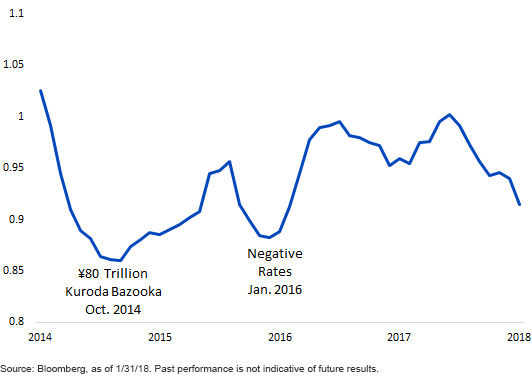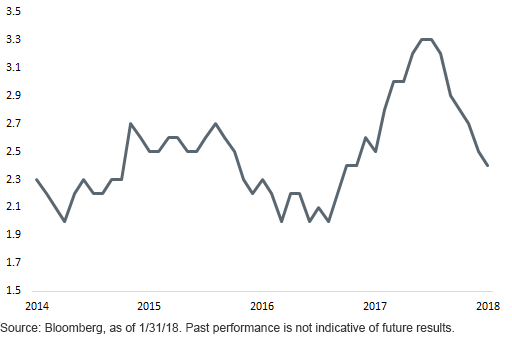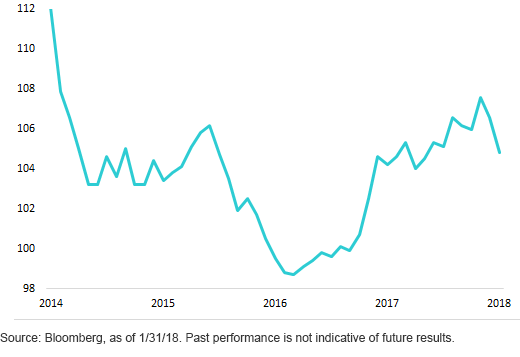All Eyes on the BOJ: From Down-Cycle Risks to Stimulus Action?


The Bank of Japan (BOJ) will hold its first policy board meeting with the newly appointed board members on April 26 and 27. In our view, there is a growing probability of the “dovish” faction gaining momentum, with at least two (and possibly three) of the nine board members voting for added monetary stimulus. The reason for this is not just the changing composition of the board—Masazumi Wakatabe, the newly appointed deputy governor, is a longstanding super-monetarist who believes there are basically neither limits nor costs to what a central bank can do; more importantly, incumbent board members won’t be able to deny the rising visibility of down-cycle risks in Japan’s economy. In short: the weaker Japan data gets in coming weeks, the more markets will be rewarded for anticipating the next pro-growth positive “Kuroda surprise.”
Already, key leading indicators have begun to roll over:
- Bank credit growth has slowed from a peak growth rate of 3.3% in mid-2017 to a mere 2.4% last month.
- Residential housing has plunged from a peak of 1 million new housing starts to barely 900,000 in recent months.
Of course, housing and bank credit are closely correlated—as much as two-thirds of Japan’s new domestic credit demand stems from mortgages and durable goods-related consumer finance. Together these two indicators offer the best insight into the cyclical dynamics of the single most important force of domestic demand, Japanese households. Unless the February and March data reveals a decisive positive inflection out of the current downturn, policy makers should be worried about more fundamental downside risks building momentum.
We stress housing as the key leading indicator because residential investment has been a definite beneficiary of “Kurodanomics,” the most concrete link from the BOJ’s actions to the real economy. Specifically, the “Kuroda bazooka” of October 2014 (when the ¥80 trillion balance-sheet growth target was announced) certainly kick-started the late-2014/2015 housing boom, and the introduction of “negative rates” in late-January 2016 triggered the sharp upturn in housing for the rest of the year (see figure 1).
Make no mistake—residential housing investment has been a key positive transmission mechanism for Kurodanomics to boost domestic demand. Japanese households have proven to be very elastic in the face of falling interest rates. From here, the conundrum facing the policy board is that, with mortgage rates at rock-bottom lows (10-year fixed rates as low as 60 basis points), added positive stimulus may be difficult to engineer from monetary policy alone; however, in our view, that should not discourage policy board members from trying.
A “Tankan Shock” in Early April?
Meanwhile, the upcoming Tankan survey, due April 2, is poised to deliver a most simple and direct warning to the BOJ and “Team Abe.” The combination of yen strength, trade protectionism, falling stock prices and growing uncertainty over the global outlook may very well force a sharp drop in the all-important Tankan business conditions and confidence index. Of course, after eight quarters of strong consecutive strong increases, a cyclical correction maybe well be overdue. However, if, as we suspect, the major tankan indexes drop by more than 5 or 6 points, BOJ governor Kuroda will come under growing pressure to counter economic down-cycle risks.
To be sure, the ultimate reliability of high-frequency data for the January to March quarter can be questioned, with volatile winter weather patterns as well as changing Chinese lunar new year schedules possibly distorting seasonal adjustment. However, we very much doubt that these academic concerns will prevent Team Abe from an urgent call to action from the BOJ, if indeed the data keeps turning down. After all, Prime Minister Abe is up for re-election in September this year, and he will want to avoid a 2018 economic downturn at all costs.
Globally, the call for a coordinated and synchronized “exit” from monetary stimulus has become deeply entrenched as the main story line for markets—i.e., both Japan and Europe will follow the “beautiful exit” led by the Federal Reserve. This makes sense as long as the synchronized economic up cycle persists, as it did very powerfully last year (2017). But as soon as growth cycles decouple, so will monetary policy.
All said, we think that Japan’s policy debate will be forced to refocus on the need for added pro-growth policy as the visibility of real economy down-cycle risks seem likely to grow in coming months. Unless the data inflects decisively upward in coming months, the probability of another pro-growth “Kuroda surprise entry” is getting higher than the probability of an “exit.”
Figure 1: Residential Housing Starts, in Millions

Figure 2: Total Bank Credit, Loans and Discounts—Year-over-Year Percentage

Figure 3: Japan’s Leading Indicators Index

Unless otherwise stated, all data is from Bloomberg as of January 31, 2018.
Important Risks Related to this Article
Investments focused in Japan increase the impact of events and developments associated with the region, which can adversely affect performance.


